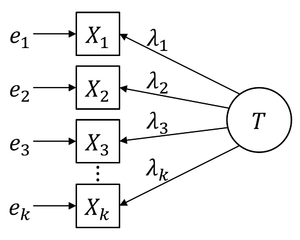Congeneric reliability
In statistical models applied to psychometrics, congeneric reliability ("rho C") is the reliability of a unidimensional congeneric measurement model. It can be interpreted as an indicator of how reliably the items of such a measurement model reflect the same underlying variable. Synonymous terms are composite reliability, unidimensional omega and Raju (1977) coefficient).[1]
Relevance

Tau-equivalent reliability ( ), which has traditionally been called "Cronbach's ", assumes that all factor loadings are equal (i.e. ). In reality, this is rarely the case and, thus, it systematically underestimates the reliability. In contrast, congeneric reliability ( ) explicitly acknowledges the existence of different factor loadings. According to Bagozzi & Yi (1988), should have a value of at least around 0.6.[2] Often, higher values are desirable. However, such values should not be misunderstood as strict cutoff boundaries between "good" and "bad".[3] Moreover, values close to 1 might indicate that items are too similar. Another property of a "good" measurement model besides reliability is construct validity.
History
Congeneric reliability was first introduced by Jöreskog (1971), when he used the term "reliability" but implicitly referred to congeneric measurement models.[4] Werts et al. (1978) also used the more general term "reliability" but for the first time also used the term "composite reliability" to distinguish it from "single-item reliability".[5] As no other term was available, the term "composite reliability" was subsequently in use but has also been criticized since.[1] More recently, Cho (2016) suggested to use the term "congeneric reliability" instead.[1]
Calculation
There are different ways to calculate congeneric reliability. These ways are equivalent, i.e. they will lead to the same result. Traditionally, is calculated as follows:
Here, is the number of items of the measurement model, the factor loading of item and the observed variance of the error . An alternative way to calculate congeneric reliability suggested by Cho (2016) is realized as follows, where is the variance of the test result:
The advantage of this alternative formula is that it is embedded in Cho's (2016) system of formulas, which makes it easier to be compared to other coefficients, e.g. tau-equivalent reliability (= "Cronbach's "). This system is also the reason why the term "composite reliability" should be dismissed for the benefit of the term "congeneric reliability".
Example
The following illustrative example to calculate using the aforementioned formulas is based on Cho (2016).[1] These are the raw data of the covariance matrix:
These are the raw data of the factor loadings and errors:
Now the traditional formula from above can be used to calculate , whereby a hat above a variable indicates that the calculation is based on sample data:
Accordingly with the alternative formula of Cho (2016):
Related coefficients
A related coefficient is average variance extracted.
References
- 1 2 3 4 Cho (2016), https://dx.doi.org/10.1177/1094428116656239
- ↑ Bagozzi & Yi (1988), https://dx.doi.org/10.1177/009207038801600107
- ↑ Guide & Ketokivi (2015), https://dx.doi.org/10.1016/S0272-6963(15)00056-X
- ↑ Jöreskog (1971), https://dx.doi.org/10.1007/BF02291393
- ↑ Werts et al. (1978), https://dx.doi.org/10.1177/001316447803800412
External links
- RelCalc, tools to calculate congeneric reliability and other coefficients.
- Handbook of Management Scales, Wikibook that contains management related measurement models, their indicators and often congeneric reliability.